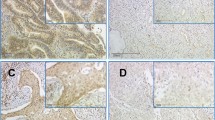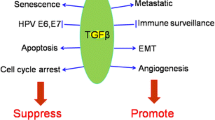Abstract
Purpose
Cervical cancer is one of the most frequent cancers in women worldwide. In most of all cases, a persistent HPV infection is the leading cause. HPV-specific sequences are able to bind glucocorticoid receptor (GR). Dexamethasone can increase the activity of early promoters in HPV16 and HPV18 interfering in transcription control of viral oncogenes. The aim of our study was to evaluate glucocorticoid receptor as transcriptional factor in its active form in the nucleus of in cervical cancer cells and to correlate the results with clinical patient specific parameters.
Methods
A total of 250 paraffin-embedded cervical cancer samples obtained from patients having undergone surgery for cervical cancer were used for the study. The expression of GR was immunhistochemical examined and evaluated by a semi-quantitative scoring. SPSS software was used for the statistical evaluation of staining results and survival analysis of patients with cervical cancer.
Results
GR is frequently expressed in cervical carcinoma tissue in favor of squamous cell carcinoma (SCC). An enhanced expression is correlated with rather small clinical stages. The expression of the GR is correlated with better overall survival and progression-free survival.
Conclusions
The glucocorticoid receptor is frequently expressed in cervical carcinoma tissue in favor of squamous cell carcinoma. An enhanced expression is correlated with rather small clinical stages. The expression of the analyzed receptor is correlated with better overall survival. Further studies are needed to determine useful treatment targets for glucocorticoid receptor manipulation.


Similar content being viewed by others
References
Munoz N, Bosch FX, Castellsague X, Diaz M, de Sanjose S, Hammouda D, Shah KV, Meijer CJ (2004) Against which human papillomavirus types shall we vaccinate and screen? The international perspective. Int J Cancer 111:278–285
Serrano-Olvera A, Cetina L, Coronel J, Duenas-Gonzalez A (2014) Follow-up consultations for cervical cancer patients in a mexican cancer center. Comparison with NCCN guidelines. Asian Pac J Cancer Prev 15:8749–8752
Horn LC, Beckmann MW, Follmann M, Koch MC, Mallmann P, Marnitz S, Schmidt D, German Cancer S (2015) s3 guidelines on diagnostics and treatment of cervical cancer: demands on pathology. Pathologe 36:585–593
Schiffman M, Castle PE, Jeronimo J, Rodriguez AC, Wacholder S (2007) Human papillomavirus and cervical cancer. Lancet 370:890–907
Wittekindt C, Wagner S, Mayer CS, Klussmann JP (2012) basics of tumor development and importance of human papilloma virus (HPV) for head and neck cancer. Laryngorhinootologie 91(Suppl 1):S1–S26
Munoz N, Bosch FX, de Sanjose S, Herrero R, Castellsague X, Shah KV, Snijders PJ, Meijer CJ, International Agency for Research on Cancer Multicenter Cervical Cancer Study G (2003) Epidemiologic classification of human papillomavirus types associated with cervical cancer. N Engl J Med 348:518–527
Liu J, Cheng Y, He M, Yao S (2014) Vascular endothelial growth factor c enhances cervical cancer cell invasiveness via upregulation of galectin-3 protein. Gynecol Endocrinol 30:461–465
Meng CF, Su B, Li W (2011) DNA demethylation is superior to histone acetylation for reactivating cancer-associated genes in ovarian cancer cells. Mol Med Rep 4:1273–1278
Gupta S, Takhar PP, Degenkolbe R, Koh CH, Zimmermann H, Yang CM, Guan Sim K, Hsu SI, Bernard HU (2003) The human papillomavirus type 11 and 16 e6 proteins modulate the cell-cycle regulator and transcription cofactor trip-br1. Virology 317:155–164
Scheffner M, Huibregtse JM, Vierstra RD, Howley PM (1993) The hpv-16 e6 and e6-ap complex functions as a ubiquitin-protein ligase in the ubiquitination of p53. Cell 75:495–505
Pittayakhajonwut D, Angeletti PC (2010) Viral trans-factor independent replication of human papillomavirus genomes. Virol J 7:123
Bromberg-White JL, Meyers C (2002) The upstream regulatory region of human papillomavirus type 31 is insensitive to glucocorticoid induction. J Virol 76:9702–9715
Chan WK, Klock G, Bernard HU (1989) Progesterone and glucocorticoid response elements occur in the long control regions of several human papillomaviruses involved in anogenital neoplasia. J Virol 63:3261–3269
Webster K, Taylor A, Gaston K (2001) Oestrogen and progesterone increase the levels of apoptosis induced by the human papillomavirus type 16 e2 and e7 proteins. J Gen Virol 82:201–213
Kwasniewska A, Postawski K, Gozdzicka-Jozefiak A, Kwasniewski W, Grywalska E, Zdunek M, Korobowicz E (2011) Estrogen and progesterone receptor expression in HPV-positive and HPV-negative cervical carcinomas. Oncol Rep 26:153–160
Fonseca-Moutinho JA, Cruz E, Carvalho L, Prazeres HJ, de Lacerda MM, da Silva DP, Mota F, de Oliveira CF (2004) Estrogen receptor, progesterone receptor, and BCL-2 are markers with prognostic significance in cin iii. Int J Gynecol Cancer 14:911–920
Chen YH, Huang LH, Chen TM (1996) Differential effects of progestins and estrogens on long control regions of human papillomavirus types 16 and 18. Biochem Biophys Res Commun 224:651–659
Schlossmacher G, Stevens A, White A (2011) Glucocorticoid receptor-mediated apoptosis: mechanisms of resistance in cancer cells. J Endocrinol 211:17–25
Block TS, Murphy TI, Munster PN, Nguyen DP, Lynch FJ (2017) Glucocorticoid receptor expression in 20 solid tumor types using immunohistochemistry assay. Cancer Manag Res 9:65–72. https://doi.org/10.2147/CMAR.S124475
Stiasny A, Freier CP, Kuhn C, Schulze S, Mayr D, Alexiou C, Janko C, Wiest I, Dannecker C, Jeschke U et al (2017) The involvement of e6, p53, p16, mdm2 and gal-3 in the clinical outcome of patients with cervical cancer. Oncol Lett 14:4467–4476
Friese K, Kost B, Vattai A, Marme F, Kuhn C, Mahner S, Dannecker C, Jeschke U, Heublein S (2018) The g protein-coupled estrogen receptor (gper/gpr30) may serve as a prognostic marker in early-stage cervical cancer. J Cancer Res Clin Oncol 144:13–19
Vattai A, Cavailles V, Sixou S, Beyer S, Kuhn C, Peryanova M, Heidegger H, Hermelink K, Mayr D, Mahner S et al (2017) Investigation of rip140 and lcor as independent markers for poor prognosis in cervical cancer. Oncotarget 8:105356–105371
Beyer S, Zhu J, Mayr D, Kuhn C, Schulze S, Hofmann S, Dannecker C, Jeschke U, Kost BP (2017) Histone h3 acetyl k9 and histone h3 tri methyl k4 as prognostic markers for patients with cervical cancer. Int J Mol Sci. https://doi.org/10.3390/ijms18030477
Marth C, Landoni F, Mahner S, McCormack M, Gonzalez-Martin A, Colombo N, Committee E G (2017) Cervical cancer: ESMO clinical practice guidelines for diagnosis, treatment and follow-up. Ann Oncol 28:iv72–iv83
Reich O, Regauer S, Marth C, Schmidt D, Horn LC, Dannecker C, Menton M, Beckmann MW (2015) Precancerous lesions of the cervix, vulva and vagina according to the 2014 who classification of tumors of the female genital tract. Geburtshilfe Frauenheilkd 75:1018–1020
Freier CP, Stiasny A, Kuhn C, Mayr D, Alexiou C, Janko C, Wiest I, Jeschke U, Kost B (2016) Immunohistochemical evaluation of the role of p53 mutation in cervical cancer: Ser-20 p53-mutant correlates with better prognosis. Anticancer Res 36:3131–3137
Stiasny A, Kuhn C, Mayr D, Alexiou C, Janko C, Wiest I, Jeschke U, Kost B (2016) Immunohistochemical evaluation of e6/e7 hpv oncoproteins staining in cervical cancer. Anticancer Res 36:3195–3198
Kolben TM, Kraft F, Kolben T, Goess C, Semmlinger A, Dannecker C, Schmoeckel E, Mayr D, Sommer NN, Mahner S et al (2017) Expression of sialyl lewis a, sialyl lewis x, lewis y, gal-3, gal-7, stmn1 and p16 in cervical dysplasia. Future Oncol 13:145–157
Vanderbilt JN, Miesfeld R, Maler BA, Yamamoto KR (1987) Intracellular receptor concentration limits glucocorticoid-dependent enhancer activity. Mol Endocrinol 1:68–74
Gehring U, Mugele K, Ulrich J (1984) Cellular receptor levels and glucocorticoid responsiveness of lymphoma cells. Mol Cell Endocrinol 36:107–113
Herr I, Buchler MW, Mattern J (2009) Glucocorticoid-mediated apoptosis resistance of solid tumors. Results Probl Cell Differ 49:191–218
Arora Vivek K, Schenkein Emily, Murali Rajmohan et al (2013) Glucocorticoid receptor confers resistance to anti-androgens by bypassing androgen receptor blockade. Cell 155(6):1309–1322
Hunt H, Donaldson K, Strem M, Zann V, Leung P, Sweet S, Connor A, Combs D, Belanoff J (2017) Assessment of safety, tolerability, pharmacokinetics, and pharmacological effect of orally administered cort125134: An adaptive, double-blind, randomized, placebo-controlled phase 1 clinical study. Clin Pharmacol Drug Dev 7(4):408–421. https://doi.org/10.1002/cpdd.389
Hunt HJ, Belanoff JK, Walters I, Gourdet B, Thomas J, Barton N, Unitt J, Phillips T, Swift D, Eaton E (2017) Identification of the clinical candidate (r)-(1-(4-fluorophenyl)-6-((1-methyl-1 h-pyrazol-4-yl)sulfonyl)-4,4a,5,6,7,8-hexah ydro-1 h-pyrazolo[3,4-g]isoquinolin-4a-yl)(4-(trifluoromethyl)pyridin-2-yl)methano ne (cort125134): a selective glucocorticoid receptor (gr) antagonist. J Med Chem 60:3405–3421
Funding
The study was supported by the “Heuer Stiftung” for Bernd P. Kost. The authors would like to thank Prof. Dr. med. Jutta Engel, M.P.H. and Max Wiedemann (The Munich Cancer Registry of the Tumorzentrum München [TZM—Munich Tumor Center]) for the follow-up data.
Author information
Authors and Affiliations
Contributions
BPK: project development, data collection. SB: experiments, manuscript writing. LS: data collection, manuscript editing. JZ: data analyses. DM: supervision, data analyses. CK: experiments, methodology. SS: experiments, methodology. SH: experiments, methodology. SM: data analyses, supervision, funding. UJ: supervision. HH: manuscript edition, data analyses
Corresponding author
Ethics declarations
Conflict of interest
All authors declare that they have no conflict of interest.
Ethical approval
All procedures performed in studies involving human participants were in accordance with the ethical standards of the institutional and/or national research committee and with the 1964 Helsinki declaration and its later amendments or comparable ethical standards. This article does not contain any studies with animals performed by any of the authors.
Informed consent
The study was approved by the ethics committee of the Ludwig-Maximilians University Munich (reference number 259-16). Patient data were anonymized.
Rights and permissions
About this article
Cite this article
Kost, B.P., Beyer, S., Schröder, L. et al. Glucocorticoid receptor in cervical cancer: an immunhistochemical analysis. Arch Gynecol Obstet 299, 203–209 (2019). https://doi.org/10.1007/s00404-018-4928-9
Received:
Accepted:
Published:
Issue Date:
DOI: https://doi.org/10.1007/s00404-018-4928-9




